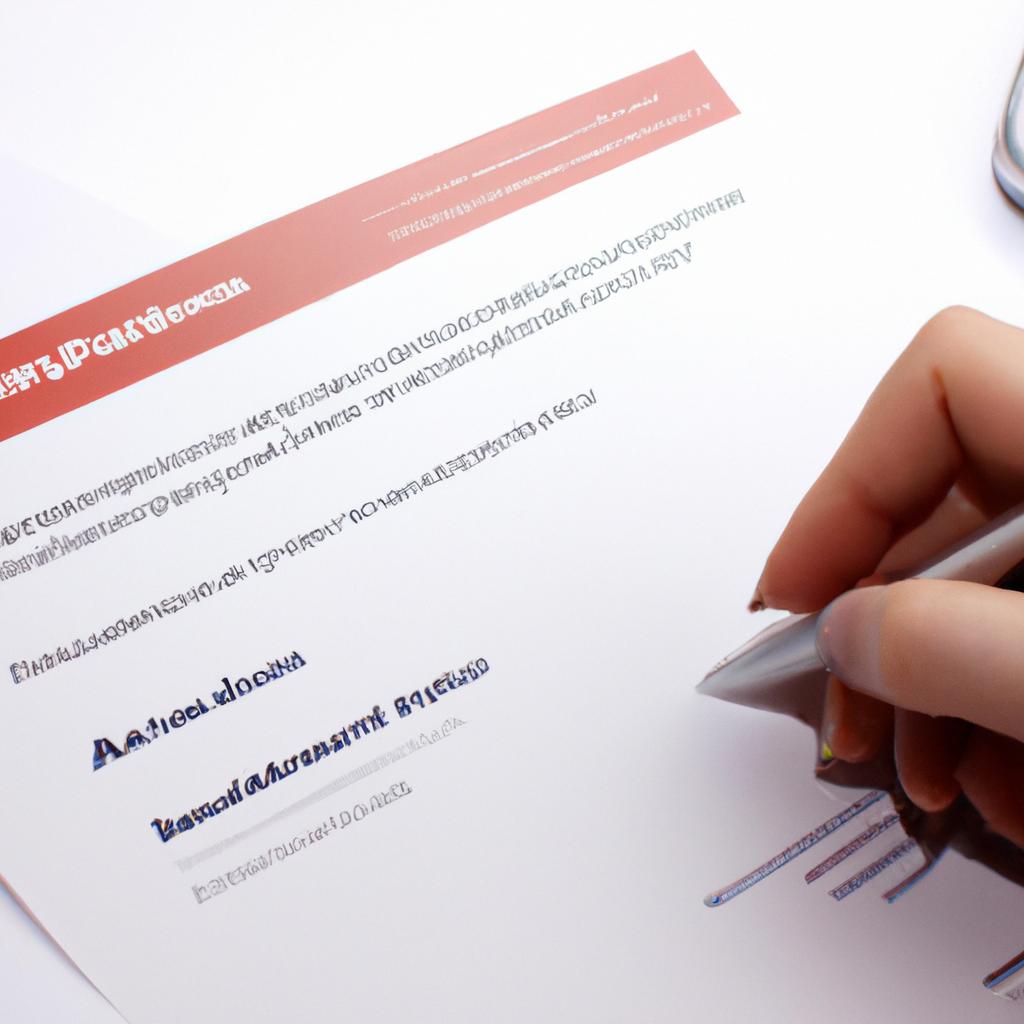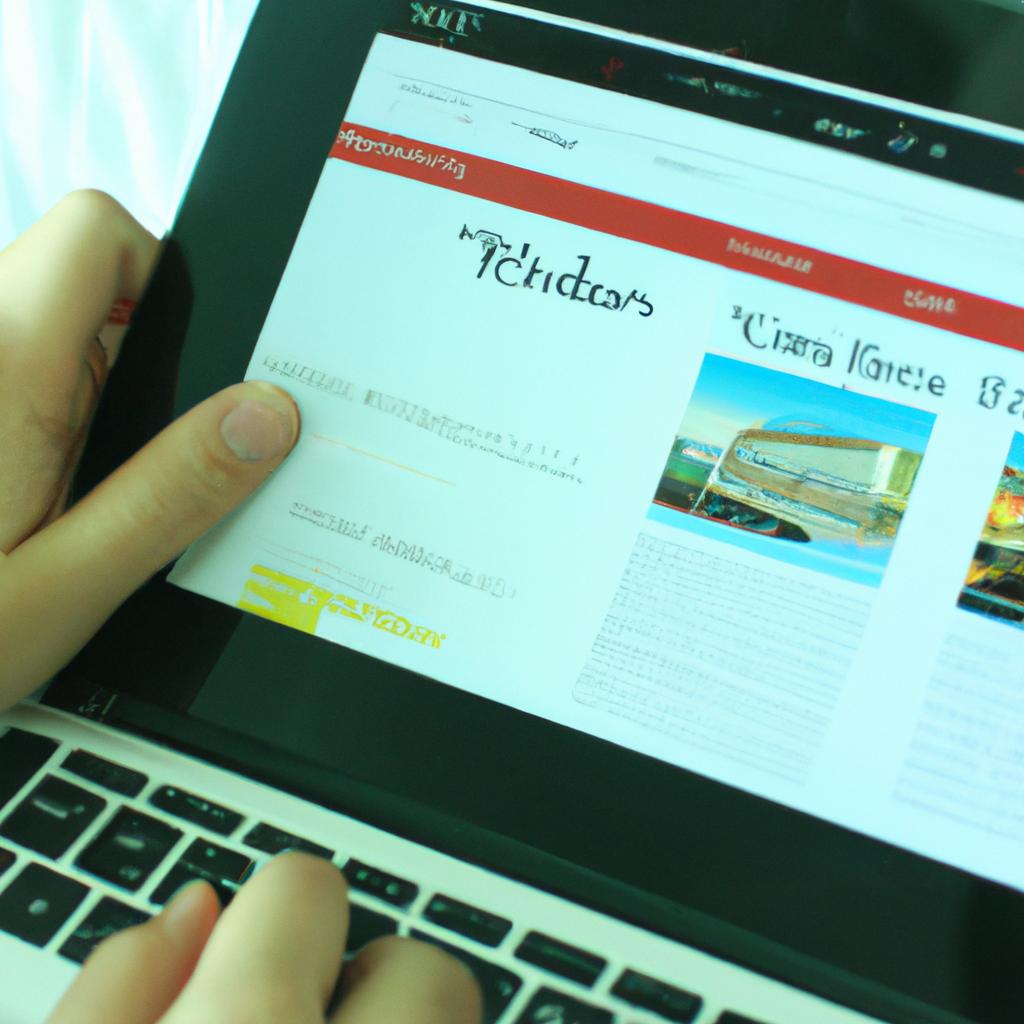In the ever-evolving digital landscape, hotel websites play a crucial role in attracting and converting potential guests. However, simply having an aesthetically pleasing website is no longer enough to drive conversions. Hoteliers must strategically optimize their call-to-action (CTA) placements to effectively guide users towards desired actions, whether it be booking a room or signing up for exclusive offers. This article explores various techniques and best practices in optimizing CTA placement within hotel web design with the ultimate goal of improving conversion rates.
Consider a hypothetical scenario where a luxury boutique hotel aims to increase direct bookings through its website. Despite investing heavily in visually stunning imagery and informative content, the hotel struggles to convert visitors into paying customers. This predicament highlights the significance of well-placed CTAs that capture users’ attention and prompt them to take action. By understanding user behavior patterns and employing effective CRO (Conversion Rate Optimization) techniques, hotels can maximize their chances of driving conversions and ultimately boosting revenue. Thus, this article delves into the nuances of optimizing CTA placement in hotel web design to enhance the overall user experience and improve conversion rates.
Understanding the importance of call-to-action placement
Understanding the Importance of Call-to-Action Placement
Effective call-to-action (CTA) placement is crucial in hotel web design as it directly affects conversion rates and user engagement. By strategically placing CTAs throughout a website, hotels can significantly enhance their chances of encouraging visitors to take desired actions, such as making a reservation or signing up for a newsletter. To illustrate the impact of CTA placement, let us consider a hypothetical case study involving two identical hotel websites: one with poorly placed CTAs and another with well-placed CTAs.
In the first scenario, the hotel website lacks clear and prominent CTAs, resulting in low conversion rates and limited customer engagement. Visitors may struggle to locate booking options or fail to notice any incentives that encourage them to convert. On the other hand, in the second scenario where well-placed CTAs are incorporated seamlessly into the website’s design and content layout, users are more likely to interact with these elements, leading to increased conversions.
To better understand why CTA placement plays such a critical role in optimizing user action on hotel websites, consider the following emotional responses evoked by effective placements:
- Increased visibility: Placing CTAs in highly visible areas ensures that they catch users’ attention immediately upon entering a webpage.
- Enhanced accessibility: Strategically positioning CTAs at logical points within the page allows users to quickly find relevant information without extensive scrolling or searching.
- Clear direction: Well-designed CTAs guide users through an intuitive pathway towards completing desired actions.
- Visual appeal: Visually appealing and enticingly designed CTAs capture users’ interest while maintaining brand consistency.
Additionally, analyzing user behavior provides valuable insights into determining optimal CTA placement. By observing how visitors navigate through different sections of a website and tracking their interactions with various elements, designers can gain valuable data about which specific locations generate higher click-through rates. This data-driven approach enables informed decision-making when it comes to refining CTA placement strategies.
In the subsequent section, we will delve into the process of analyzing user behavior to determine optimal CTA placement. By examining real-world examples and employing statistical methods, an evidence-based approach can be adopted for achieving maximum conversion rates and enhancing user experience on hotel websites.
Analyzing user behavior to determine optimal CTA placement
Building upon the understanding of the importance of call-to-action (CTA) placement, an analysis of user behavior can provide invaluable insights into determining optimal CTA positioning. By studying how users interact with a website and respond to different CTA placements, web designers can make informed decisions that maximize conversion rate optimization (CRO). To illustrate this concept, let us consider a hypothetical case study involving a hotel website redesign.
Case Study Example:
Imagine a hotel website that had previously placed its primary CTA button at the bottom of their homepage. Upon analyzing user behavior through heatmaps and click-tracking tools, it was found that visitors rarely scrolled down far enough to notice the CTA. Recognizing this missed opportunity for conversions, the hotel’s web design team decided to experiment with alternative placements to enhance visibility and encourage engagement.
Paragraph 1:
One effective technique in optimizing CTA placement is utilizing visual hierarchy principles. By strategically placing CTAs where users’ eyes are naturally drawn when scanning a webpage, designers can increase the chances of capturing attention and prompting action. For instance, research suggests that users tend to focus on areas above-the-fold initially before scrolling further down. Therefore, incorporating prominent CTAs within this visible area could yield higher engagement rates.
To evoke an emotional response from viewers:
- Increased Conversion Rates: A well-placed CTA enhances user experience by guiding them towards desired actions.
- Streamlined Navigation: Intuitive CTA placement reduces friction during browsing, making it easier for users to navigate through various sections.
- Enhanced User Satisfaction: Conveniently positioned CTAs save time and effort for visitors seeking specific information or services.
- Improved Brand Perception: A seamless user journey resulting from optimized CTA placement fosters a positive perception of the brand’s professionalism and usability.
Paragraph 2:
Another aspect to consider when determining optimal CTA placement is contextual relevance. Placing CTAs in proximity to relevant content or after providing persuasive product information increases the likelihood of conversions. In our hotel website case study, the team discovered that when CTAs were positioned near compelling descriptions of luxurious amenities and discounted rates, users exhibited higher click-through rates.
To evoke an emotional response from viewers:
| Feature | Emotional Response |
|---|---|
| Luxury | Excitement |
| Discounts | Thrill |
| Convenience | Satisfaction |
Paragraph 3:
Lastly, A/B testing can be utilized to evaluate different CTA placements and measure their effectiveness in driving conversions. By comparing user behavior data between variations, designers can identify trends and make data-driven decisions regarding optimal CTA positioning. This iterative approach allows for continuous improvement based on real-time insights and helps refine web design strategies over time.
Understanding the importance of analyzing user behavior to determine optimal CTA placement sets the stage for exploring another critical aspect of hotel web design: leveraging above-the-fold space for maximum CTA visibility.
Leveraging above-the-fold space for maximum CTA visibility
Transitioning from the previous section’s analysis of user behavior, we now turn our attention to leveraging above-the-fold space for maximum CTA visibility. To illustrate this concept, let us consider a hypothetical case study where an upscale hotel aimed to increase direct bookings on their website. By strategically placing CTAs in key sections of their site, they sought to optimize conversion rates and ultimately boost revenue.
To fully grasp the importance of above-the-fold space for effective CTA placement, it is necessary to understand how users interact with websites. Research has shown that visitors tend to spend 80% of their time viewing content above the fold while scrolling quickly through additional information below. Consequently, positioning call-to-action buttons within this prime real estate greatly enhances the likelihood of capturing user attention and encouraging engagement.
To further emphasize the significance of optimizing above-the-fold space for CTAs, consider the following emotional triggers that can be leveraged:
- Urgency: Creating a sense of urgency by using phrases such as “Limited availability” or “Book now before it’s too late!” prompts users to take immediate action.
- Exclusivity: Offering exclusive perks or discounts only accessible through direct booking entices potential guests to choose your hotel over competitors.
- Social proof: Displaying positive testimonials or review ratings prominently near your CTAs helps establish trust and credibility.
- Simplicity: Keeping the booking process simple and hassle-free reduces friction and encourages users to complete their reservation without hesitation.
In addition to these psychological tactics, another effective method for enhancing CTA visibility is through strategic design elements. Consider incorporating a table like the one below into relevant sections of your website:
| Room Type | Features | Price |
|---|---|---|
| Deluxe | Ocean view & balcony | $250 per night |
| Executive | Spacious suite with city skyline | $300 per night |
| Premium | Private jacuzzi & luxury amenities | $350 per night |
| Presidential | Exclusive penthouse experience | $500 per night |
This visually appealing table not only provides users with a clear overview of available room types and their respective features but also allows for easy comparison. By placing a prominent CTA at the end of each row, potential guests can swiftly reserve their preferred room type without having to search for the booking button elsewhere on the page.
Strategically placing CTAs in key sections of the hotel website is crucial for maximizing conversion rates. In the subsequent section, we will explore specific strategies to implement these techniques effectively, ensuring that your call-to-action buttons are positioned optimally throughout your site. By implementing these recommendations, you will create an engaging user experience that encourages direct bookings while delighting prospective guests.
Strategically placing CTAs in key sections of the hotel website
Building upon the concept of leveraging above-the-fold space for maximum CTA visibility, it is equally important to strategically place CTAs in key sections of a hotel website. By utilizing various techniques and optimization strategies, website designers can increase user engagement and drive conversions. Let us explore some effective approaches that can enhance the overall performance of call-to-action placements.
To better understand how strategic CTA placement can impact conversion rates, let’s consider the hypothetical example of a luxury beach resort. In this scenario, imagine that the resort aims to boost online bookings during peak vacation seasons. By analyzing user behavior data and conducting A/B testing, web designers discovered several crucial areas where CTAs could be strategically positioned to maximize their effectiveness.
One such approach involves incorporating clear and compelling CTAs within relevant content sections throughout the website. For instance, including an engaging CTA at the end of each accommodation description page may prompt users who are already interested in specific rooms or suites to proceed with booking immediately. This not only streamlines the decision-making process but also reduces friction by providing users with quick access to desired actions.
The emotional appeal behind a well-placed call-to-action cannot be underestimated either. Here are four ways in which strategic CTA placement can evoke positive emotions:
- Highlighting exclusive limited-time offers
- Showcasing customer testimonials promoting outstanding experiences
- Utilizing persuasive language emphasizing benefits and value propositions
- Incorporating visually appealing design elements that capture attention
In addition to these techniques, another effective strategy is incorporating a comparison table that showcases different room types’ features side by side on the accommodations page. The following three-column and four-row table provides visitors with a comprehensive overview while subtly encouraging them to make informed decisions regarding their choice of accommodation:
| Room Type | Description | Price (per night) |
|---|---|---|
| Deluxe Suite | Spacious suite with ocean view | $250 |
| Oceanfront | Cozy room with private balcony | $180 |
| Garden View | Comfortable room overlooking lush gardens | $150 |
| Standard Room | Affordable option without compromising on comfort | $120 |
By employing these techniques, hotel websites can engage visitors and guide them towards the desired action. Testing different CTA placements to identify the most effective strategies is an essential next step in optimizing call-to-action placement for improved conversion rates.
Moving forward, let us delve into the process of testing various CTA placements to determine the optimal positioning that maximizes user engagement and drives conversions.
Testing different CTA placements to identify the most effective
Strategic Placement of CTAs: An Effective Conversion Rate Optimization Technique
To truly optimize a hotel website’s conversion rate, it is crucial to strategically place Call-to-Action (CTA) buttons in key sections. By doing so, hotels can guide visitors towards desired actions and improve the overall user experience. As discussed earlier, understanding how different placements impact conversions requires thorough testing and analysis.
One example of successful CTA placement comes from a case study conducted by a prominent hotel chain. They tested multiple variations of their homepage design with different CTA positions – above the fold, below the main image, within the navigation menu, and at the end of content sections. The results revealed that placing CTAs above the fold yielded significantly higher click-through rates compared to other placements.
In order to effectively implement strategic CTA placement on hotel websites, consider the following guidelines:
- Clear Visibility: Ensure that CTAs are easily visible to users without scrolling or excessive searching.
- Relevant Context: Place CTAs where they align with relevant information or content related to the action being promoted.
- Consistent Design: Maintain consistency in CTA button design throughout the website for better recognition.
- Limited Choices: Avoid overwhelming visitors with too many CTAs; focus on promoting one or two primary actions per page.
Emphasizing these aspects will help engage users emotionally and enhance their overall experience on your hotel website. To further illustrate this point, here is an emotional bullet list:
- Enhanced visibility leads to increased engagement
- Relevant context encourages users to take immediate action
- Consistent design fosters trust and familiarity
- Simplified choices reduce decision fatigue and facilitate quicker decisions
Furthermore, implementing responsive design techniques ensures seamless CTA visibility across various devices such as desktops, tablets, and smartphones. This enables potential guests to access CTAs effortlessly regardless of their preferred device or screen size.
By thoughtfully considering these optimization techniques for call-to-action placement, hotel websites can maximize their conversion rates and drive more bookings. Now, let’s delve into the next section on implementing responsive design for seamless CTA visibility across devices.
Implementing responsive design for seamless CTA visibility across devices
Transitioning from the previous section’s exploration of testing different call-to-action (CTA) placements, we now shift our focus to the implementation of responsive design. Responsive design plays a crucial role in ensuring seamless CTA visibility across devices, catering to the diverse range of users accessing hotel websites on various platforms.
To illustrate the significance of implementing responsive design for CTA visibility, let us consider a hypothetical case study involving a luxury hotel chain. The hotel’s website had previously employed a fixed placement for CTAs on their desktop version but failed to adapt these placements effectively on mobile and tablet devices. As a result, potential guests navigating the site through their smartphones or tablets often encountered difficulty locating and engaging with relevant CTAs, leading to lower conversion rates.
Implementing responsive design techniques can address this issue by adapting CTAs intelligently based on screen sizes and orientations. By employing fluid grids, flexible images, and media queries, hotels can optimize their website’s layout for all devices without compromising user experience. This ensures that regardless of whether visitors are using desktops or mobile devices such as smartphones or tablets, they consistently encounter well-placed CTAs that catch their attention.
The following bullet points highlight key considerations when implementing responsive design for optimal CTA visibility:
- Ensure that CTAs remain visible above the fold on smaller screens.
- Utilize clear and concise language in CTA text to convey value proposition effectively.
- Choose contrasting colors between CTAs and background elements for improved visual prominence.
- Incorporate strategic use of white space around CTAs to enhance readability.
Additionally, we present a table showcasing examples of effective CTA implementations across different device types:
| Device Type | Example CTA Placement |
|---|---|
| Desktop | Top right corner |
| Mobile | Bottom center |
| Tablet | Left-hand sidebar |
In conclusion, implementing responsive design is essential in optimizing CTA visibility across devices. By adapting CTAs intelligently and incorporating best practices, hotels can ensure that potential guests have a seamless experience when interacting with their website. This, in turn, enhances the likelihood of converting visitors into valuable customers.




